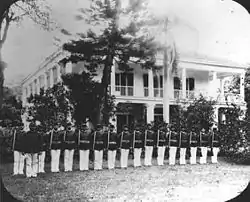Royal Guards of Hawaii
The Royal Guard of the Hawaii National Guard is an Air National Guard ceremonial unit which is uniformed in a manner similar to the royal bodyguard of the Kingdom of Hawaii of the late 19th century. The original 50-man unit had been disbanded by King Lunalilo after the barrack mutiny of 1873, reestablished by King Kalakaua, and finally abolished when the monarchy fell in revolution at the end of the 19th century.
| Royal Guard of the Hawaii National Guard | |
|---|---|
 | |
| Active | 1854–1873 1874–1893 |
| Country | |
| Allegiance | Kingdom of Hawaii State of Hawaii |
| Branch | Air National Guard |
| Type | Honor guard (current) |
| Size | 42 |
| Part of | Hawaii Air National Guard |
| Engagements | 1868 Kaona uprising 1873 Barracks Revolt |
.jpg.webp)

The current Royal Guards were raised in 1962 as a purely ceremonial unit. Each guardsman is a Hawaiian resident, a member of the Hawaii Air National Guard, of full or partial Hawaiian descent. The unit appears in support of the Governor at official State and other public functions; less frequently, the unit appears at ceremonies involving descendants of former Hawaiian royalty.
In 1963, the Royal Guards consisted of 14 men. It has grown to a strength of 42.
Weapons
Ranks
- Kapena Moku (Captain)
- Luna Koa (1st Lieutenant)
- Lutanela (2nd Lieutenant)
- He Kakiana (First Sergeant)
- Kakiana Ekahi (Sergeant 1st Squad)
- Kakiana Elua (Sergeant 2nd Squad)
- Kakiana Ekolu (Sergeant 3rd Squad)
- Kakiana Eha (Sergeant 4th Squad)
- Kaiana Pu (Ordnance Sergeant)
- Kapala Ekahi (Corporal 1st Squad)
- Kopala Elua (Corporal 2nd Squad)
- Kopala Ekolu (Corporal 3rd Squad)
- Kopala Eha (Corporal 4th Squad)
- Kopala Hae (Color Guard Corporal)
- 1 Hookani Pahu (Drummer)
- 27 Koa (Soldiers)
Uniform
- Navy Blue Jacket
- White pants
- White Pith Helmet
- Black Shoes
External links
| Wikimedia Commons has media related to Royal Guards of Hawaii. |